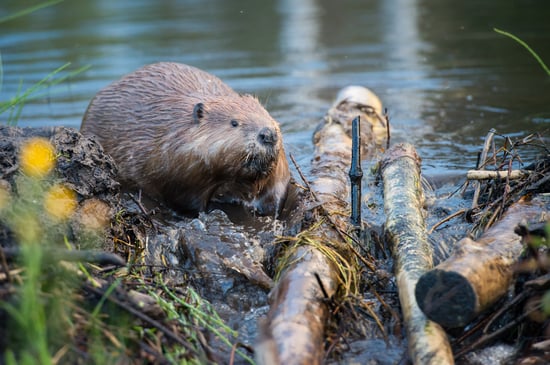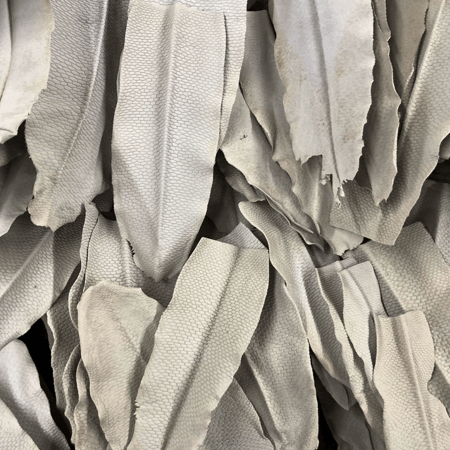Beaver tail has incredibly unique natural qualities, which make it ideal for watch bands, footwear, holsters, sheets and other small leather goods. Selecting the best beaver tail for your project requires some knowledge of how beaver tail is harvested, tanned, priced, sized and cared for to ensure your product lasts a long time.
Beaver Background

Throughout North America, beavers are sustainably sourced and humanely harvested, caught by licensed trappers during a single law-enforced season in areas where they cause great ecological disturbances.
Beavers are considered a nuisance species and cause many negative environmental and economic externalities, related to the damage they cause to downstream farmers (upstream beaver dam problems), germs and bacteria they put into fresh water, and the damage they cause to tree farms. Reducing the beaver population improves water flow and quality, improves crop yields, reduces the tax burden on residents in poor rural communities, and generates economic value for people in those same areas.
Beaver tails are rich in historical value and are filled with the Americana culture. Beavers were one of the first hides that sparked the fur trade between the Native Americans and European sailors in the 1500's. Today, beaver tails are not a byproduct of the fur business. Fur prices are so low, that trappers are not going after them. As a result, the supply of beaver tails is extremely limited.
The texture and durability of beaver tail leather is incredibly unique. It is naturally scratch-resistant and water-resistant, making it a perfect material for watch bands, wallets, card cases, holsters, sheaths, and other small leather goods.
Sustainable Beaver Tail Harvesting

As noted above, harvesting beaver tail is a sustainable practice. The beaver tails used by Pan American Leathers come from a species of beaver known by the scientific name Castor Canadensis. These are native to North America.
The beaver tail scores a perfect 10 out of 10 in the PanAm Leathers Sustainability and Ethics Rating System. Animal welfare systems have been developed and implemented. Beavers are exclusively trapped in the wild, where there is a thriving estimated population of over 10 million beavers. The tails are a byproduct of the beaver meat industry.
The beavers are wild, free roaming, free range animals that fill a niche in their ecosystem without barriers. Once captured, these beavers receive as quick and humane a dispatch as any domesticated animal does when it's their time. State and local agencies implement and enforce laws that ensure trappers meet these ethical standards. If a particular beaver is trapped and removed from an area that provides adequate food and habitat, a new beaver will move into that area within weeks. If the area that a particular beaver was trapped in has been depleted by the local beaver population, then the next beaver will move onto "greener pastures" and the surrounding habitat will be left alone to regenerate. And the sustainability cycle continues.
All beavers are legally trapped and dispatched following state regulations. In most states, trappers must be certified via Trapper Education courses, as well as have a trapping license to trap and sell the animals that they trap. The state’s corresponding departments set laws according to guidelines that ensure the most humane and ethical treatment of animals being trapped. For example, in Minnesota, traps must be checked every 24 to 72 hours, depending upon the type of trap used. Trapping regulations are in place to ensure that trap design, trap size and trap placement all ensure a humane catch and quick dispatch of the animal.
Trappers play an important role as both conservationists, as well as the first line of defense for animal damage and infrastructure. On the conservation side of things, if there is an overpopulation of beavers, they decimate the food and habitat in a particular area and can literally "eat themselves out of house and home." This isn't good for the beavers, but it also affects the deer, moose, ducks, reptiles, etc. that use that same habitat. Along with that, too many beavers in any given area will result in diseases and sicknesses that will eventually destroy entire populations.
From an infrastructure standpoint, beavers can be detrimental to roadways, agricultural crops and other animal habitats. Trappers are paying for equipment, licenses, gas, etc. which not only help local economies and state agencies, but also perform a service to taxpayers free of charge. If licensed trappers aren't performing these services during the trapping season, then local and state municipalities will need to spend taxpayer dollars to hire animal damage control trappers to eradicate the beavers from problem areas.
Beaver meat has sustained Native American populations throughout America and Canada for thousands of years. Many Ojibwe and Cree tribes would even set up their winter dwellings near beaver colonies knowing that they would have a continued source of protein throughout the winter that they wouldn't have to chase through the woods after. To this day, beaver meat is enjoyed as a traditional food in many Cree communities and Canada. Many trappers (me included) in the Midwest, Northeast states, and Canada eat beaver backstraps, hindquarters, ground into burger or cubed.
Pan Am Leathers uses a sustainability and ethics rating system to ensure sustainability across our entire supply chain. We want to ensure that our business is both ethical and sustainable.
Our system grades aspects of our supply chain on a variety of factors including the following:
Animal Welfare
We consider if vendor accounts provide scientifically backed standards for treatment of animals. Our grading system is as follows:
-
0: There are no standards in place, nor any effort underway to develop standards.
-
1: Standards and enforcement are being developed.
-
2: Standards and enforcement are already in effect.
Biodiversity
This measures if vendors adopt a closed-circuit farm, where animals are bred in captivity, or if they are using a wild-bred animal program. The biodiversity grading system consists of the following:
-
0: Captive-bred species from farms that we have not personally visited and are not certified by an organization like ICFA or SARCA.
-
1: Captive-bred species from farms we have personally visited or are otherwise certified Good farms personally inspected by us or that are certified get 1.
-
2: Wild-bred species.
Conservation
We use this to grade the level of conservation efforts being used to ensure that wild populations continue to flourish. Nearly 6,000 species of animals and 30,000 species of plants are protected by CITES.
Depending on the degree of protection they need, CITES species are broken into three categories. Our grading system is based on these appendices:
-
1: Appendix I contains species threatened with extinction under which trade is only acceptable under extraordinary circumstances. We do not grade this a 0 because the problem has been recognized and steps are being taken to address it.
- 2: Appendix II species are not in danger but must be trade-controlled to prevent exploitation.
- 3: Appendix III fauna and flora are protected in at least one country, and so CITES countries participate in controlling its trade.
- 4: Non-appendix species do not require CITES control because there is no credible threat to their survival.
Meat Harvesting
The meat from reptiles and other exotic species is a great source of protein and nutrition for billions of people across the world. We want to ensure that if there is a market for the meat, then the animal being harvested is also being prepared for meat products as well.
That being said, some meat from these animals should not be consumed by humans, so government agencies may be implementing a nuisance program to address species that are causing disturbances in the environment.
The grading system we use for this is as follows:
-
0: Meat isn't used for human consumption for no good reason.
-
1: Meat isn’t used for human consumption for one of the reasons described above.
-
2: Meat is used for human consumption.
Our Ethics and Sustainability Rating for Beaver Tail
The beaver tail scores a perfect 10 out of 10 in the Pan Am Leathers Sustainability and Ethics Rating System. Beavers are exclusively trapped in the wild, where there is a thriving estimated population of over 10 million beavers. The tails are a byproduct of the beaver meat industry.
Beaver Tail Tanning
The tanning process for exotic leathers varies depending on the animal. Generally, we follow the process below for beaver tail tanning:
-
Split the beaver tail into top and bottom halves.
-
Remove the excess flesh on the back of each side.
-
Soak the beaver tails in a cleaning solution.
-
Remove hair using a chemical solution, then rinse off remaining stray hairs.
-
Conduct chrome-tanning to convert animal skin into leather.
-
Use vegetable-based extracts to re-tan and soften the thinned skins.
-
Add beaver tails into coloring drums to dye the hides.
-
Apply a finish to the hides to achieve the desired look and feel (most commonly glazed, matte, etc.).
Beaver Tail Characteristics
Beaver tail has a unique-matrix like scaling pattern with natural scratch and water-resistance. PanAm processes and stocks tails that run approximately:
-
7-12 inches long, average 8.5 inches
-
3-5 inches wide, average 3.5 inches
-
1.7-2.1 mm thick in the center, getting thinner towards the tip of the tail
PanAm Leathers grades beaver tail on the center 8” x 2.5” rectangle only. The grades are defined as follows:
-
Grade 1: No defects in the center rectangle
-
Grade 2: One cluster of defects in the center rectangle
-
Grade 3: Worse than grade 2
Common defects are cuts, scratches, scars and scaling defects.
Common Uses For Beaver Tail
Beaver tail leather has several uses, depending upon its grade:
- Grade 1 beaver tail is most commonly used for watch bands, footwear, electronics accessories and wallets.
- Grade 2 beaver tail is most commonly used for holsters, sheats, card cases and other small leather goods.
- Grade 3 beaver tail is used on goods that don’t require a clean surface, perhaps for an intentional look of wear and tear, or for craftsmen practice.
Watch Band Yields For Beaver Tail
As beaver tails are often used for watch bands, we have used a size 20R standard watch band style to estimate yields of watch bands per beaver tail for the various sizes and grades of beaver tails available:
|
Length (in.) |
Grade I |
Grade II |
|
8.00-8.99 |
1-2 bands |
1 band |
|
9.0+ |
3-4 bands |
2-3 bands |
Caring for Beaver Tail
Beaver tail is naturally resistant to water and scratches, so your products should last a long time with everyday wear and tear. Here are some tips on how to make it last as long as possible:
-
Store beaver tail away from direct sunlight, moisture, and excessive heat.
-
Avoid harsh cleaning chemicals. Instead, opt for using mild soap with a damp towel, but make sure you dry it completely after cleaning.
-
Add protection by applying specialized leather conditioners.
At PanAm Leathers, our team is proud to carry a wide array of beaver tail products. We also provide several types of services, like contract tanning, leather services, and custom orders.
Check out more of our blog, and if you’re in the market for beaver tail products, contact us to get started on your order!



